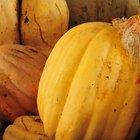
If you're planning a big event or simply need some dinner items made ahead to save time, you can store cooked squash up to four days. This means making it three days ahead gives you squash for the meal and some leftovers for the next day if it isn't all eaten. Beyond the fourth day, toss out the unused squash and make a fresh batch.
Proper Cooling
Cook your squash however you like, but you must cool it properly for safe storage. Rather than setting the squash out to cool on the countertop when cooking is finished, clear out space in your refrigerator and put the squash directly into the fridge. Set it on a hot pad or trivet on the refrigerator shelf with plenty of space on all sides so you don't warm up your other foods. In particular, don't set it below or directly next to dairy products. The squash must drop from above 140 degrees to below 40 degrees in approximately 40 minutes or less to prevent bacteria growth. Cut whole squash into pieces for faster cooling, and spread thick squash casseroles or soups out so they are less than 2 inches deep in their pans.
Proper Storage
After the squash cools to below 40 degrees, cover it tightly with plastic wrap or place it in a tightly lidded container. Squash has a high water content and can dry out quickly if not covered. It also absorbs flavors around it, which is a great asset in cooking, but less of a benefit in the fridge, where it can pick up unwanted flavors from other dishes or ingredients it is stored near.
Reheating
Before serving your squash, reheat it in the oven or on the stovetop until the internal temperature reaches 165 degrees. You can also microwave your precooked squash, but this can result in a rubbery texture and uneven heating, leading to unpleasant cold spots. If you do choose to microwave, cover the squash with waxed paper or a paper towel and stir it halfway through the cooking time, if it is a stirrable dish. As with more traditional reheating methods, heat it until the squash is 165 degrees at its center.
Considerations
Even with tight covering, water can be pulled out of the squash during storage. In this case, you may see a puddle resting on the top of your squash dish, under its wrapping. Stir the water back in if it's a soup or other stirrable dish. Drain it off and pat the squash dry with a clean white paper towel if you can't stir it in, or if it doesn't reabsorb or dry off when you reheat the squash before serving.
Related Articles

Can I Freeze Large Zucchini and Summer ...

How to Blanch Squash for Freezing
How to Cook a Large Hubbard Squash

How to Cook Delicata Squash Cut in Half

How to Clean Butternut Squash

How to Thicken Mashed Squash

How to Cook Buttercup Squash

How to Store & Keep Zucchini and Squash ...
Can You Cook Chicken Wings the Day ...

How to Cook Zuccini & Squash in a ...

Baked Cubed Squash

How to Cook Butternut Squash Fast
Can You Freeze Eggplant Parmesan After ...

How to Prepare Peter Pan Squash

How to Cook Papaya Pear Squash

How to Cook Butternut Squash in the ...
What to Do With Leftover Spaghetti ...
How to Boil Chayote
How Long Can Leftovers Be Refrigerated?

How to Slow Cook Pork Chops & Vegetables
References
Writer Bio
Anne Hirsh has been writing and editing for over 10 years. She has hands-on experience in cooking, visual arts and theater as well as writing experience covering wellness and animal-related topics. She also has extensive research experience in marketing, small business, Web development and SEO. Hirsh has a bachelor's degree in technical theater and English and post-baccalaureate training in writing and computer software.
Photo Credits
Hemera Technologies/PhotoObjects.net/Getty Images